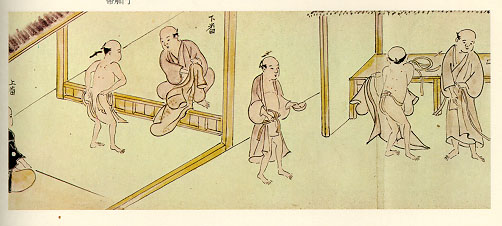
|
comments? corrections? |
The basic difference between the manufacture of East Asian cash coins and West Asian/European coins is that cash coins are cast in molds while the latter are struck with dies. The oldest Chinese cash were cast in molds of clay, but this changed to casting them in molds of fine sand instead. Sand molds allow the molten metal to flow more freely and can produce finer features than clay molds. On this page I will introduce how coins were made in Japan in the 18th century using the sand mold technique.
|
| The description below follows selections from the Zeniza emaki ("Cash Mint Picture Scroll") which is reproduced in Nihon Ginkou Chousakyoku ed., Zuroku Nihon no kahei, vol.3 (Tokyo: Touyou Keizai Shinpousha, 1974), pp. 72-79 with notes on pp. 116-117. This scroll pictures the Sendai Ishinomaki mint in the year 1728 and is the oldest scroll picturing copper coin manufacture in Japan. |
| Arriving to work meant a complete change of clothing into work clothes provided by the proprietors of the mint. Coming and going, this was done between two inspectors seated in front and in back of the worker to prevent theft of coins. Similar methods (including x-ray scans) are used by money producers and gem and precious metal miners throughout the world today. |
 |
| Anciently Chinese coins were cast using clay molds, but from the early 600's the use of the sand mold method became common. Japan used the sand mold method from the very beginning of its minting history in the late 600's. The sand mold uses two frames filled with fine grain wetted sand, and a set of carefully manufactured "seed coins" or "mother coins." The man on the right is laying the mother coins on the sand in the mold. He also lays down rods to create the basic path for the molten metal to flow into the space of each coin. After the mother coins are laid out, the second frame filled with sand is laid on top. The man on the left is walking on the paired frames to make sure that the sand presses tightly to the mother coins, so as to produce a fine image. |
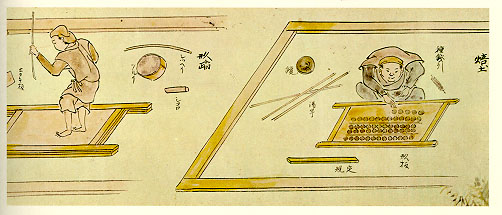 |
| After the mold of the mother coins is pressed sufficiently, the front and back of the mold are separated. The man on the right is cutting clean paths to each coin for the molten metal. The man in the center is removing the mother coins leaving the negative imprint in the sand. The man on the left is heating the sand filled frames with smoky pine. This dries the sand but the resin smoke helps the sand stick together to maintain its shape. The carbon also helps the molten metal flow more smoothly. Coins fresh from the mold are usually covered in pine resin soot. |
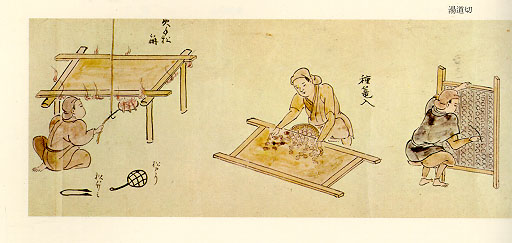 |
| After the mold is prepared then the two sides are clamped tightly together, as on the right side of this picture. The man on the left is finishing the final stages of preparing the molten metal. This was a mixture of copper with lead, tin, nickel, iron or other metals including, I was surprised to learn, toxic metals such as mercury and arsenic. Copper was usually predominant but some coins contain so much nickel or iron that they can be picked up with a magnet. Others contain so much lead that they are chalky and grey. The relative proportions of metal were often subject to availability and market forces. |
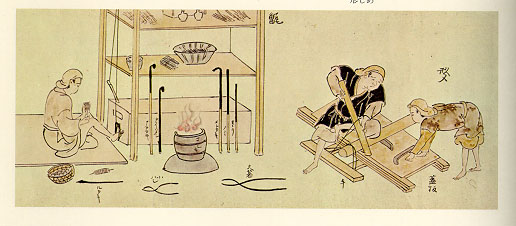 |
|
This picture shows the workers on the right pouring the molten metal into the sand mold, which has been stood up on its end. The man in the center is removing the coins from the mold after it has cooled and been opened up. The picture makes it seem as if he is removing them one by one, but this seems unlikely. The copper in the path to the coins has cooled as well and the coins are lifted out by this frame of hardened metal. They look like leaves on a branch. This is called in English a "coin tree" or in Japanese an "edasen." They are then cut or broken off the branch one by one. Some coins will have the traces of where the metal path came into their edge, either a slight lump still sticking out or a bite into the edge of the coin itself where the coin was broken off clumsily. |
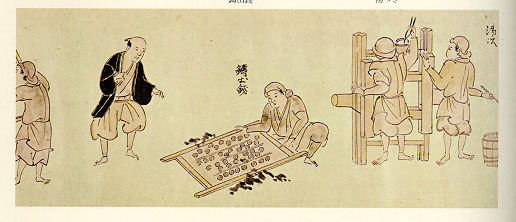 |
| After the coins are broken off the "tree" then they are placed on square rods and filed down so that the edges are smooth as possible. The two men in the center are filing the outside edges of the coins, while the man on the left is filing the inside square hole. This is time consuming and expensive to do, so one mon coins from the late Edo period are frequently not filed as carefully as earlier coins. In terms of care of production the 1660's was probably the apogee of Japanese cash coin manufacture. It is interesting that this coincides with the apogee of Tokugawa and daimyo lord authority as well. From the mid-eighteenth century producers learned how to make more coins faster and more cheaply but all in all the quality declines. The Sendai mint pictured here had excellent quality control and made beautiful coins even in the eighteenth century. |
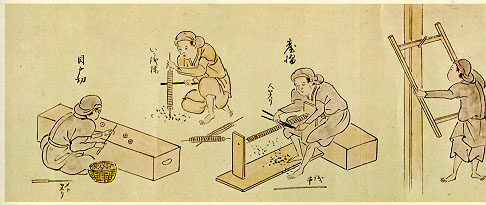 |
| Next the coins are reheated in order to strenghten them. This is pictured on the right. Then they are checked by the man on the left to make sure that they are flat. Bent ones are presumably recycled. |
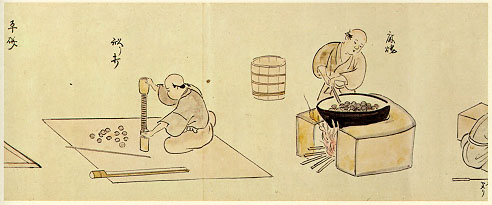 |
| These men seem to be polishing the surfaces of the coins and doing other checking for quality. Many coins also are made with accidental holes in them due to the metal cooling too quickly, so most of these are caught during manufacture and recycled. Some such coins nevertheless enter circulation. |
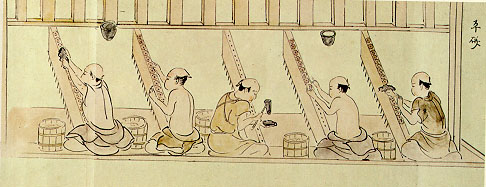 |
| The men on the right are giving the coins all strung on a rod a final rounding polish. The men on the left are stomping on the coins in a large pestle. Why? well the book cited above says "It must be part of the production process." So there. An anthropologist would say "It must be a religious rite." |
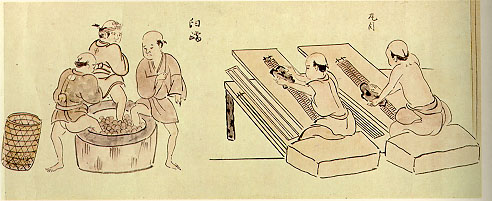 |
| Next the coins are washed to remove filing dust etc. as being done by the man on the right. The water is then screened to retrieve the metal for recycling. This is called Genta nagashi. I have not included the picture here. After being washed the coins are dried to prevent early corrosion. |
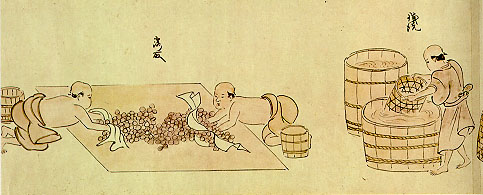 |
| The men on the right are yet again polishing the outside edges of the coin on a bed of straw. The men on the left are tying the coins onto strings of a standard count of say 300 or 500 coins. |
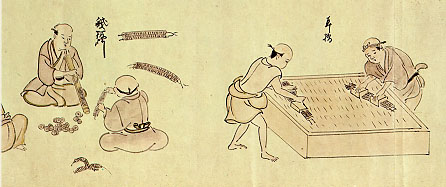 |
| These men are stacking and counting the strings of coins. The man on the lower left is counting and recording the amounts in an account book set by him on the floor. The man on the top center seems to have unstrung a roll to inspect. Perhaps he is another quality control man. |
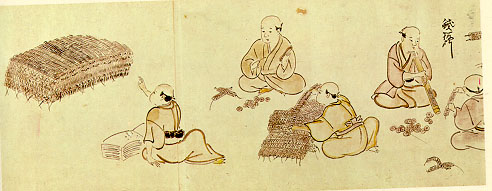 |
| The producer of the coins is a subcontractor to the government. He keeps an agreed-upon portion for his income and to cover production costs and then gives up the remainder to the government which is run by samurai. In this case the government is that of Sendai domain. This picture shows the owner or manager going with a bevy of servants carrying the coins to the government coin office. |
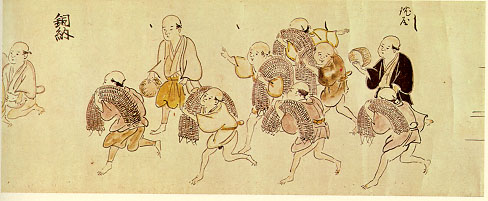 |
| The coins are then laid upon the "coin stage" at the samurai government office. Most of the commoner workers are beneath the status permitting them to step up on the floor of the office so they wait kneeling below. Two commoner inspectors (kabiya) crouch on stage while behind him a man announces the arrival while beating a drum. |
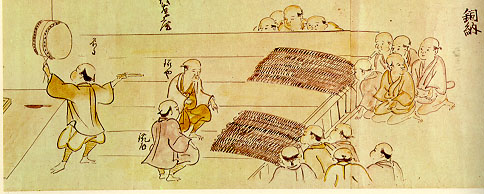 |
| In this the last stage, samurai officials inspect and accept the coins. Notice the swords, markers of their status, which they have laid on the floor beside them. The chief officials are at the far left and they inspect a few samples presented them in trays. A white document, probably presenting sum totals, sits on the floor in front of one of these samurai. In the lower right sits two people. One is the Chief Inspector of the domain, the Oometsuke. To his right sits a representative of the domain accounting office, kanjougata, and he is weighing a string of coins to confirm that they meet specifications. Manufacturers like to shrink the size of the coins to save money. The three men at top center, called "myoudai," are some kind of representative but of whom I do not know. The two men at the right are two more representatives of the Chief Inspector's office. |
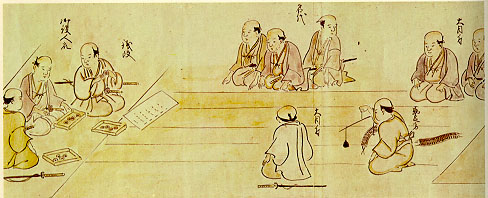 |
The End go to top